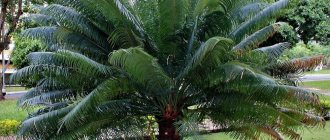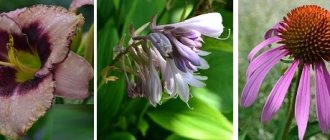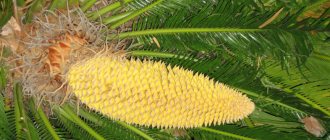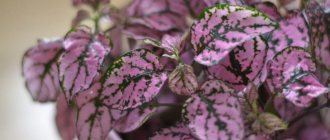The Cycas plant, also called the sago palm or cycad, is related to the only genus of gymnosperms in the Cycad family. According to information taken from various sources, this genus includes from 90 to 200 different species. In nature, such a culture can be found in Asia (from Japan to India), on such Pacific islands as Samoa, Fiji, Mariana, and also in Madagascar. Remains of cycas were found in the crustal sediments of the Mesozoic period. Despite the fact that most of the representatives of the Cycad family have long been impossible to meet in nature, cicadas are quite widespread only due to the fact that they are unpretentious. Today, such a palm tree is in great demand among flower growers, despite the fact that it is quite expensive.
Brief description of cultivation
- Bloom . Cycas is cultivated as an ornamental foliage plant.
- Illumination . The bush needs diffused bright light or partial shade.
- Temperature regime . During the growing season - room temperature, in winter - at least 15 degrees.
- Watering . In winter it should be scanty, and in summer it should be moderate.
- Air humidity . High - from 70 to 80 percent. Experts advise moistening the foliage with a sprayer quite often, and also its surface should be wiped with a dampened soft cloth, and the trunk should also be regularly wrapped with moistened sphagnum moss.
- Fertilizer . This fern is fed during intensive growth once every 4 weeks; for this, organic matter is used that does not include magnesium and potassium, for example, a solution of horse manure or mullein is well suited. It is not recommended to use mineral fertilizers for fertilizing.
- Rest period . It is relative, it begins in late autumn and ends in the first weeks of spring.
- Transplant . Young bushes are replanted once every 2 or 3 years. It is not recommended to replant adult ferns, but the top layer of substrate in their pot must be replaced every year. To do this, remove the top layer of soil mixture, about 50 mm thick, and then pour fresh substrate into the pot.
- Reproduction . To do this, you can use lateral shoots (if available). Only specialists can grow cycas from seeds.
- Harmful insects . Scale insects, aphids, mealybugs, spider mites.
- Diseases . Root rot, caudex rot, chlorosis.
Transplanting a plant
A fertile and loose substrate is an ideal choice for Cycas Revoluta. The plant will have to be replanted annually until it reaches the age of 6 years. After this, transshipment can be done once every 5 years.
The flower can only be replanted in early spring. At this time, the plant does not have young leaves and sensitivity to traumatic influences is reduced.
The cycad does not tolerate damage to the root system when the earthen ball is destroyed, so the flower is replanted using the transshipment method, having previously placed a drainage layer on the bottom of the new planting container. You need to act quickly, but carefully.
The capacity for each new transplant should be 5 cm larger than the previous one. It is advisable to choose those pots whose height is only slightly greater than their width. It is better to avoid plastic pots. The plant grows poorly in them.
Features of Cycas
Externally, the cicada has many similarities with a palm tree; for example, it is a tree whose height can vary from 2 to 15 m, while its trunk is quite thick. If a plant reaches a height of about 300 cm, then the thickness of its trunk in girth is, as a rule, 100 cm. The surface of the trunk is “chained in a shell”, consisting of the remains of leaf plates that have already died. The doubly pinnate or pinnate foliage is similar to the leaf blades of a fern that grow from the top of the trunk. The lifespan of such a plant most often exceeds 100 years. Cycas in indoor conditions has a height of 0.5–0.8 m, while over the course of 1 year its increase in height is no more than 30 mm, and it produces only 1 row of leaf blades. Young leaf plates are rich green in color, soft and with slight pubescence; after a while they darken, become bare, hard and shiny. When grown indoors, this plant is very similar not to a tree, but to a bush. It is interesting that most gardeners believe that cycas is a palm tree, because even its name comes from the ancient Greek word “kykas”, translated as “palm tree”, but in fact this plant has nothing to do with palm trees. However, it is a relative of the fern. Since this plant is slow growing, it is often grown as a bonsai.
When grown indoors, such a crop blooms extremely rarely. At the top of the trunk of the female plant, large orange seeds are formed in cones, the length of which varies from 30 to 50 mm. But in order for the seeds to be viable, cycas should be grown in greenhouse conditions, and the efforts of an experienced specialist will also be required.
Cycas care at home / Indoor palm tree
Origin
Among plants that look like a palm tree, the Cycas Revoluta occupies a leading place.
Due to this similarity, the Swedish botanist Carl Linnaeus gave it the appropriate name, derived from the Greek kikas, which means “palm tree”. At one time, Linnaeus, misled by the external signs of the cycas, placed it in his system among the palm trees.
At the end of numerous debates about the “relatives” of the cycas, scientists have come to the conclusion that this plant is not directly related to the palm family. But the leaves are very similar in shape to ferns, therefore, there is a close relationship between these species.
Caring for a cicada at home
Lighting
Before you start growing cycas at home, you need to find the most suitable place. If you decide to buy an already mature plant, you should remember that it will need quite a lot of space. The domestic cycas is distinguished by its love of light, but it should be taken into account that if the foliage is exposed to direct sunlight, the life of the leaf blades will be shortened, and they will also become less attractive. You can grow the bush in partial shade, but in this case the young leaves will grow very, very slowly.
Temperature
Cycas grows well at room temperature. However, in winter, coolness suits him best, but you must make sure that the temperature in the room is not less than 15 degrees.
Watering
In order for the plant to grow well and develop properly, it must be provided with the correct watering regime. In summer, it should be watered moderately. And in winter, you will need to reduce watering, and the volume of water poured under the bush at a time directly depends on what the air temperature is in the room. So, the warmer the room, the more water will be needed for watering and the more often it should be done. Water the cicada with settled soft water at room temperature (or 1–2 degrees warmer). Make sure that during watering the liquid does not get into the crown of the bush.
Air humidity
This plant requires high air humidity (from 70 to 80 percent). To increase the level of air humidity, it is recommended to regularly moisten the foliage from a spray bottle with well-settled water, the trunk must be wrapped in moistened moss, and the surface of the leaf plates must be wiped quite often with a dampened soft cloth.
Top dressing
Cycas must be fed systematically once every 4 weeks during its intensive growth; for this purpose, organic matter is used, which does not contain potassium and magnesium salts. This palm tree responds best to feeding with a solution of horse manure or mullein. The bush should not be fed with mineral fertilizers.
Transfer
Young bushes need regular replanting, which is carried out once every 2 or 3 years. Adult specimens are transplanted only if they are very cramped in the old pot. A suitable pot should be 20–30 mm in diameter larger than the diameter of the bush’s trunk, while its depth should be 2–2.5 times the diameter of the trunk. For example, if a pot with a diameter of 15 centimeters is suitable for planting, then its depth should be from 30 to 35 centimeters.
The substrate must be slightly acidic or neutral and allow water to pass through well. So, the liquid should pass very quickly through the soil mixture and flow into the pan. In order for the substrate to pass water very quickly, it must contain large perlite, pumice, coarse peat or very coarse sand. The approximate composition of the substrate suitable for growing such a crop: one part of coarse pine bark, coarsely crushed charcoal, coarse perlite, slag (or pumice), pebbles (or crushed stone) and coarse peat, and also add 1/10 of bone meal . The substrate is thoroughly mixed and then sterilized. Even if you use a suitable substrate for planting, you still need to make a good drainage layer at the bottom of the pot.
Transplantation can be carried out at any time of the year when necessary. However, the best time for such a procedure is spring, before intensive growth of the bush begins. During the formation of young leaf blades, it is not recommended to replant cycas, as in this case the foliage can be easily injured. Before you start replanting, you need to cut off 1/3 of the foliage, starting with the oldest ones. When replanting a bush, try not to injure its root system, since if the thick roots are damaged or deformed, the risk that rot will appear on the plant increases.
CICASA TRANSPLANT | Soil composition, choice of pot
General information
Chicuta, which looks like a palm tree, is an evergreen plant of the gymnosperm group. According to the taxonomic classification, the genus belongs to the cicadas and includes about 90 species. It is distributed in tropical and subtropical countries of the Asian-Australian region.
Cognitive! Representatives of this genus were first described and given scientific names in the mid-18th century.
The plant has a rather thick trunk, hidden under a crust of petioles of dead leaf blades, on top of which there is a dense crown of feathery leaves. Different specimens of Cicaceae vary significantly in size depending on growing conditions: no more than 60 cm in indoor culture and about 15 m in natural conditions.
This is a dicotyledonous plant. The strobili of male specimens form large cones and give the plant an original appearance.
Cycas breeding
Growing cycas from seed
In indoor conditions, it is very difficult to propagate cycas by seed. As a rule, this is done by experienced specialists in nurseries or greenhouses. The fact is that such a palm tree blooms extremely rarely in indoor conditions, and even if this happens, there will be no one to pollinate the flowers. If you have good seed in your hands, then before sowing it should be placed in lukewarm water for 24 hours, after which the seeds are evenly distributed over the surface of the perlite and slightly pressed into it. Place the crops in a warm place (not lower than 25 degrees). The first seedlings should appear 2-3 months after sowing. 1–2 months after the emergence of seedlings, they should have one true leaf blade fully formed. When this happens, the plants are transplanted into individual containers in a soil mixture intended for adult bushes.
Cycas from seeds
How to propagate by separating a shoot
If a plant is kept in conditions unsuitable for it, then shoots appear on its trunk. Take a very sharp knife and cut off the shoot, while trying not to injure the trunk. Cut off all the foliage from the offspring, treat the cut with a solution of a fungicidal preparation, and then with Kornevin. Then the offspring should be planted in very coarse sand or coarse perlite, after which they are watered. Be sure to treat the cut site on the mother plant; charcoal powder is used for this. During rooting, the shoots are placed in a shaded, warm (about 30 degrees) place, and care must be taken to ensure that the soil mixture is always slightly moist. The offspring should take root in 6–12 months. When this happens, it is carefully transplanted into a soil mixture intended for growing an adult cicada.
Usage
The core, which is densely covered with scales, contains a large amount of starch. Due to this feature, the inhabitants of the islands have been cultivating the plant since ancient times in order to obtain this product, which is used as an ingredient in the preparation of sago. In this regard, these plants received a second name - “cycad palms”. In its raw form, the cycas bulb is unsuitable for consumption. Moreover, due to the content of toxic substances, you can get poisoned. However, local residents use special neutralizing agents that allow them to extract and consume starch without harm to health, so for them it is a very valuable food product.
Pests and diseases of cycas
Pests
The greatest danger to the cycas is that scale insects are due to the fact that they have a waxy coating that reliably protects them from the effects of insecticidal preparations. Adult insects are removed from the bush manually, and to destroy the larvae, the above-ground part of the bush is treated with a systemic or contact agent, for example: Carbaryl, Pyriproxyfen, Acephate, Pyrethrin or other pyrethroids. The bushes are treated in the morning or evening, and the air temperature in the room should be below 30 degrees. If necessary, the bushes can be sprayed again after 5–10 days.
Mealybugs can also settle on such a plant. They can be found on all parts of the bush. After the harmful insects have been collected by hand, the bush is sprayed with a product that contains cypermethrin, and the substrate in the container must be moistened with such a drug. If this is necessary, the palm tree is treated again after 5 days. You can spray the bush up to 4 times.
If aphids have settled on the plant, then it must be treated with phosphorus twice or thrice with a break of 7 days.
In order to get rid of plant mites that settle in the above-ground part of the bush, you will need 3 sprays, which are carried out with a break of 7 days, for this they use a solution of an acaricidal agent.
Diseases
Most often, such a plant is affected by rot of the root system and caudex (lower part of the trunk). The affected bush must be carefully removed from the substrate, after which the remaining soil mixture must be carefully removed from the root system. Using a very sharp, pre-sterilized knife, it is necessary to cut out all soft, darkened and blackened areas. Then plant for 30 minutes. immersed in a solution of a fungicidal preparation, after this the cut areas must be treated with charcoal powder, and then the bush is left in the fresh air for several hours to dry. Then the cycas is planted in a new soil mixture, which must be disinfected; do not forget to dip its root system in a solution of a product that stimulates root growth. If during rooting all the leaf plates fly off the plant, then this is quite normal, this is how the plant tries to survive. If the inside of the trunk is affected by rot, this will lead to the inevitable death of the plant.
Cycas turns yellow
Very often, flower growers are faced with the fact that the foliage on the bush turns yellow. Despite the fact that this problem occurs very often, in most cases the plant can be saved. But in order to help him, the first step is to establish the reason why the leaves turn yellow, and there may be several of them:
- lack of microelements;
- insufficient amount of nitrogen in the substrate;
- improper lighting;
- injury to the root system.
The first problem is most often associated with the fact that the plant was not fed on time or it cannot properly absorb the applied fertilizers due to very low temperatures or because the pH of the substrate has changed; this happens when the bush is systematically watered with hard water. As a result, the development of the root system stops. If the cycas feels a lack of nutrients, then it needs to be fed, and the new foliage that appears on the bush will be of normal color. If it turns yellow due to improper care, then it will need to be transplanted into a fresh substrate, and you will need to start caring for it according to all the rules. If there is not enough nitrogen in the soil mixture, then nitrogen-containing fertilizer will need to be added to it, but the old leaf blades will still remain yellow. If the reason is improper lighting, then in this case it should be taken into account that each species has certain lighting requirements; therefore, yellowing of foliage can be associated with both an excess amount of light and its lack. In some cases, yellowing of the leaf blades begins after the bush is moved to fresh air in the spring without first hardening it off. Yellowing of the foliage of the cycas can be observed due to insufficient or very frequent watering, and also when the root system is cold or the bush has been fed with an overly concentrated nutrient mixture. In these cases, the root system signals the presence of a problem by yellowing of the leaf blades, so when such a signal appears, you should try to make every effort to save the flower.
WE SAVED A YELLOWED CICAS FROM DEATH!
Cycas is drying
Yellowing and drying of the lower leaf blades is considered a natural process. If the air humidity in the room is excessively low, then the tips of the foliage will dry out because of this; this also happens when the palm tree is fed with the wrong dosage of fertilizers.
First steps after purchase
Cycas are sold rooted, ready to grace your collection. Before purchasing, it is carefully examined, but not all pests can be detected with a quick inspection.
After purchase, it must be quarantined for a month. Wherever the plant is grown, nothing can exclude the presence of pests on it.
In addition, a new specimen can be treated with pest control drugs for preventive purposes. The plant needs to be given increased attention in order to quickly take the necessary measures in case of illness.
Types of cicada with photos and names
Below we will describe those types of cycas that are most popular among flower growers.
Drooping cycas, or wrapped cycas, or revoluta cycas (Cycas revoluta)
This species is native to southern Japan. The thick columnar trunk reaches a height of about 300 cm, and a diameter of up to 100 cm. The length of the imparipinnate leaf plates is about 200 cm, they consist of a large number of slightly bent, narrow-linear, densely spaced leathery leaves. There is pubescence on the surface of young leaves, but after a while they become bare, darker and shiny. On male bushes, narrow-cylindrical cones are about 0.8 m long and up to 15 centimeters in diameter. On female bushes, on the surface of the loose cones there is a light red fluff. The orange seeds are quite large. This type is most popular among non-professional flower growers, and this article describes it. how to care for just such a cicada.
Curled cycas, or snail-shaped cycas (Cycas circinalis = Cycas neocaledonica)
The height of the columnar-shaped trunk reaches approximately 300 cm. The length of the leaf plates is up to 200 cm, they are collected in bunches of several pieces. While the foliage is young, it is directed upward, and then it is placed horizontally. On the pinnate leaf plates there are from 50 to 60 pieces of densely arranged lanceolate-shaped leaves on each side of the midrib, their length reaches 25 centimeters and width up to 15 mm.
Cycas media
This palm-shaped tree can reach a height of about 7 m. The length of the pinnate leaf plates is up to 1.8 m. The foliage is part of a rosette located on the upper part of the trunk. The length of small male cones is about 25 centimeters, while female cones are similar in appearance to a bunch of ears of corn. In the 19th century in Northern Australia, the seeds of this plant were used as food, but they were first subjected to special processing because they are poisonous.
Cycas rumphii
The homeland of this plant is Sri Lanka, it is one of the most vigorous-growing species, its trunk has a height of 8–15 m. The pinnate leaf plates growing in bunches are about 200 cm long. The shape of the leaflets is linear-lanceolate, their length is about 30 centimeters, and their width - up to 20 millimeters.
Siamese Cycas (Cycas siamensis)
This species is native to the savannah forests of Indochina. The height of the bush reaches only 1.8 m, while the trunk is thickened from root to center, and then it becomes thinner. The length of the pinnate leaf plates is slightly more than 100 centimeters. They consist of pointed, narrow-linear whitish-blue leaves, about 10 centimeters long and 5 millimeters wide.
HOW TO CARE FOR A CYCAS IN ROOM CONDITIONS? | The magic of a light hand
Where can I buy
It is recommended to purchase seedlings or plant children in specialized stores or on websites that have positive customer reviews. You should not make a purchase in spontaneous markets. In this case, the possibility of purchasing low-quality planting material or plants cannot be ruled out.
Several online stores where you can buy drooping cycad:
- mandarin-shop;
- luxuryplants;
- tropics-seeds.
Experts recommend buying mature seedlings. In this way, many problems associated with growing young seedlings will be avoided.











